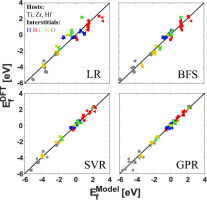当前位置:
X-MOL 学术
›
Scr. Mater.
›
论文详情
Our official English website, www.x-mol.net, welcomes your
feedback! (Note: you will need to create a separate account there.)
Machine learning-based prediction models for formation energies of interstitial atoms in HCP crystals
Scripta Materialia ( IF 5.3 ) Pub Date : 2020-07-01 , DOI: 10.1016/j.scriptamat.2020.02.042 Daegun You , Shraddha Ganorkar , Sooran Kim , Keonwook Kang , Won-Yong Shin , Dongwoo Lee
Scripta Materialia ( IF 5.3 ) Pub Date : 2020-07-01 , DOI: 10.1016/j.scriptamat.2020.02.042 Daegun You , Shraddha Ganorkar , Sooran Kim , Keonwook Kang , Won-Yong Shin , Dongwoo Lee

|
Abstract Prediction models of the formation energies of H, B, C, N, and O atoms in various interstitial sites of hcp-Ti, Zr, and Hf crystals are developed based on machine learning. Parametric models such as linear regression and brute force search (BFS) as well as nonparametric algorithms including the support vector regression (SVR) and the Gaussian process regression (GPR) are employed. Readily accessible chemical and geometrical descriptors allow straightforward implementation of the prediction models without any expensive computational modeling. The models based on BFS, SVR, and GPR show the excellent performance with R2 > 96%.
中文翻译:

基于机器学习的 HCP 晶体间隙原子形成能预测模型
摘要 基于机器学习开发了 hcp-Ti、Zr 和 Hf 晶体各种间隙位中 H、B、C、N 和 O 原子形成能的预测模型。采用线性回归和蛮力搜索 (BFS) 等参数模型以及支持向量回归 (SVR) 和高斯过程回归 (GPR) 等非参数算法。易于访问的化学和几何描述符允许直接实施预测模型,而无需任何昂贵的计算建模。基于 BFS、SVR 和 GPR 的模型表现出优异的性能,R2 > 96%。
更新日期:2020-07-01
中文翻译:

基于机器学习的 HCP 晶体间隙原子形成能预测模型
摘要 基于机器学习开发了 hcp-Ti、Zr 和 Hf 晶体各种间隙位中 H、B、C、N 和 O 原子形成能的预测模型。采用线性回归和蛮力搜索 (BFS) 等参数模型以及支持向量回归 (SVR) 和高斯过程回归 (GPR) 等非参数算法。易于访问的化学和几何描述符允许直接实施预测模型,而无需任何昂贵的计算建模。基于 BFS、SVR 和 GPR 的模型表现出优异的性能,R2 > 96%。










































 京公网安备 11010802027423号
京公网安备 11010802027423号